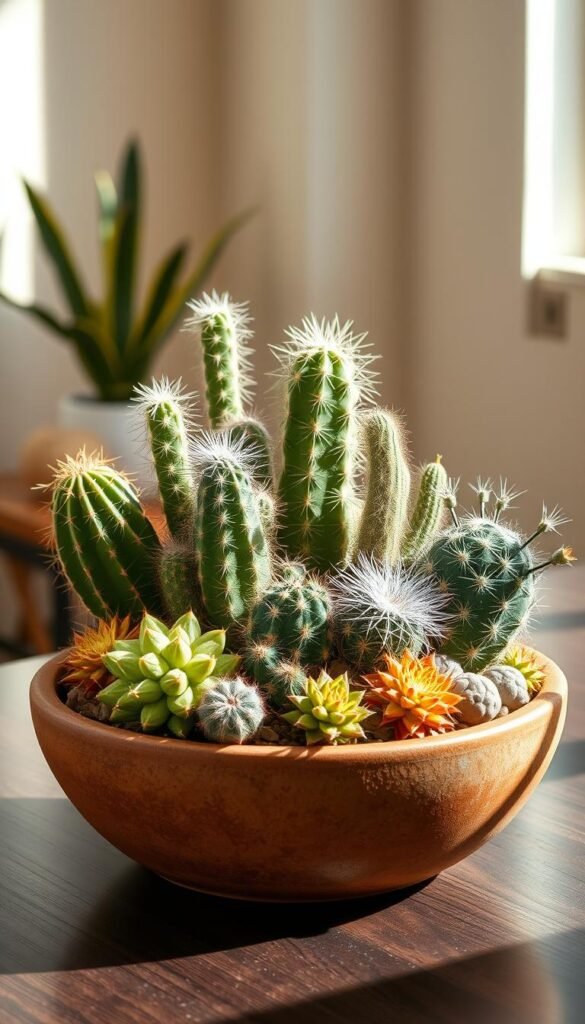Imagine a miniature desert thriving in your living room. These captivating arrangements combine rugged beauty with effortless care, perfect for adding natural style to modern spaces. Unlike fussy houseplants, they ask little but give much – striking textures, year-round interest, and conversation-starting appeal.
Drought-resistant plants shine in shallow containers that mimic arid ecosystems. Better Homes & Gardens highlights how dish garden designs let you mix shapes and sizes for visual drama. Pair spiky specimens with smooth stones or twisted driftwood to craft your personal oasis.
First-time gardeners love these projects because results appear quickly. You’ll arrange plants like living sculptures, using protective gloves when handling prickly varieties. A layer of gravel completes the desert vibe while helping soil drain properly.
These self-sufficient displays do more than look pretty. They purify air naturally and adapt to various spaces – coffee tables, office desks, or entryway consoles. With just occasional watering and bright light, your creation becomes a permanent fixture of home decor.
Getting Started with Your Mini Dish Garden
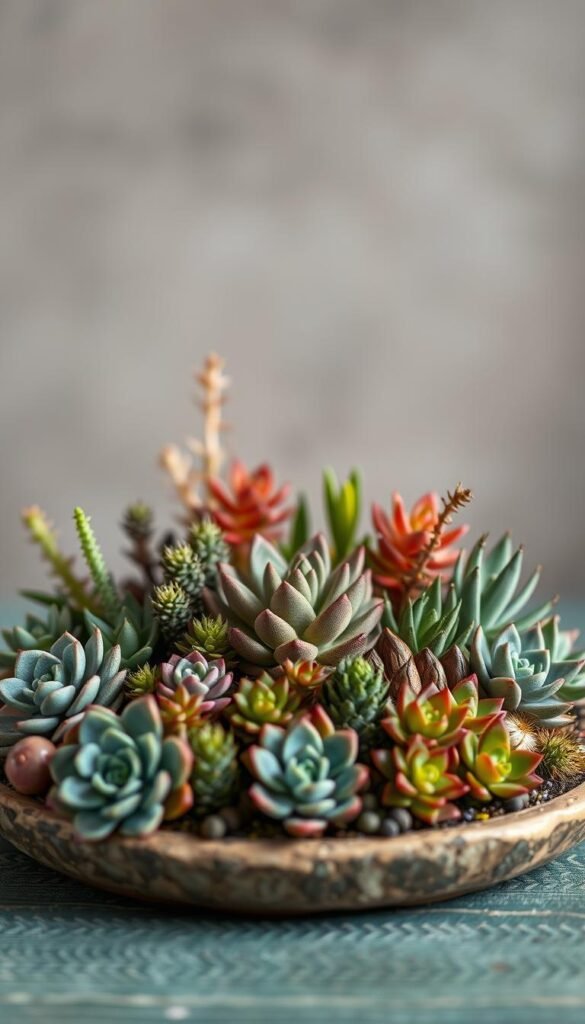
Bring nature’s charm indoors with a living artwork that thrives on neglect. These compact ecosystems let you experiment with textures and colors while fitting seamlessly into small spaces. Whether you’re crafting a permanent display or seasonal decoration, the secret lies in matching plant needs for light and water.
What Makes Dish Gardens Special
Think of your arrangement as a tiny world where succulents and stones tell a story. Unlike single-plant pots, these grouped designs create depth through contrasting shapes – spiky aloe beside rounded pebbles, or trailing sedum spilling over a ceramic edge. They’re ideal for apartments or offices since they don’t demand outdoor space. Even better, you can start small with container gardening basics and expand as your confidence grows.
Why Busy Plant Lovers Adore Them
Your creation becomes self-sufficient with minimal care. Most varieties need watering just once a month – perfect if you travel often or forget routines. The shallow dish design lets you move your garden effortlessly from windowsills to desks, adapting to your decor whims. Best of all, these living sculptures stay vibrant through snowstorms or summer heat, offering year-round visual interest without the upkeep of outdoor beds.
Gathering Your Materials and Tools
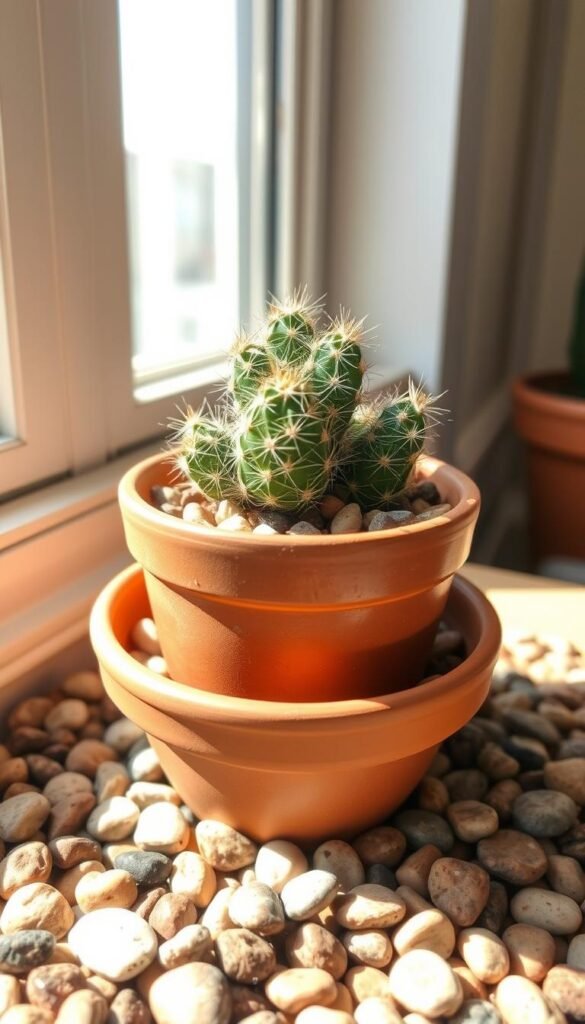
Your desert-inspired masterpiece begins with smart material choices that balance form and function. The right container and soil blend create a healthy foundation while expressing your personal style. Let’s explore what makes these elements work together seamlessly.
Selecting the Perfect Container and Ensuring Proper Drainage
Shallow containers between 3-6 inches deep give roots room to breathe without excess soil moisture. Terra cotta and ceramic pots are classics, but don’t shy away from repurposed bowls or flea market treasures. Drainage holes are non-negotiable – if your chosen dish lacks them, layer pebbles and horticultural charcoal at the base.
Material matters more than you might think. Porous terra cotta wicks away moisture faster than glazed ceramics, ideal for over-waterers. For decorative containers without drainage, use a 1-inch gravel base. This simple trick prevents soggy roots while letting your creativity shine.
Choosing the Ideal Soil Mix and Amendments
Your soil blend needs to mimic arid conditions. Combine equal parts potting soil and cactus mix for quick drainage with slight moisture retention. Pro tip: Add a handful of activated charcoal to neutralize odors and filter impurities. Local compost gives nutrients without waterlogging.
This lightweight mix allows roots to anchor securely while preventing rot. Test your blend by squeezing a handful – it should crumble immediately. If it clumps, add more perlite or coarse sand. Your plants will reward you with vigorous growth and vibrant colors.
How to Build a Cactus Dish Garden for a Low-Maintenance Centerpiece
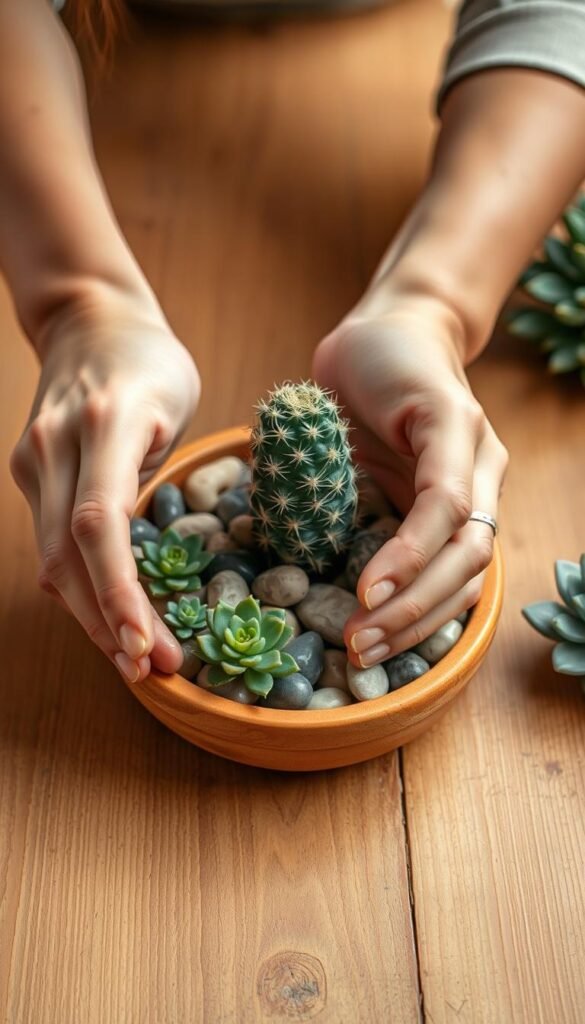
Transform your tabletop into a living canvas using methods that suit your lifestyle. Whether you prefer flexible designs or permanent displays, these techniques ensure success.
Planting Techniques: Soil vs. Grow Pots
The grow pot method lets you experiment freely. Keep nursery containers intact for easy swaps – perfect when using decorative bowls without drainage. This approach reduces mess and lets you adjust layouts seasonally.
For lasting arrangements, direct soil planting creates stability. Combine 2″-4″ specimens in shallow dishes, allowing roots to intertwine naturally. Mix heights for visual impact: position taller plants toward the back, smaller ones near edges.
Step-by-Step Assembly and Planting Process
Start by organizing materials within reach. Wear thick gloves and use kitchen tongs to handle spiky varieties safely. Create elevation with gravel if needed – this prevents soil contact with container bases.
Bury root balls just deep enough to support upright growth. Leave 1/4″ space between plants for air circulation. Top with decorative stones to secure positions while enhancing the desert aesthetic.
Rotate your creation weekly for even light exposure. Observe how different textures play off each other – fuzzy mammillaria beside angular agave creates captivating contrasts. Your living sculpture evolves beautifully with minimal effort.
Caring for Your Indoor Dish Garden
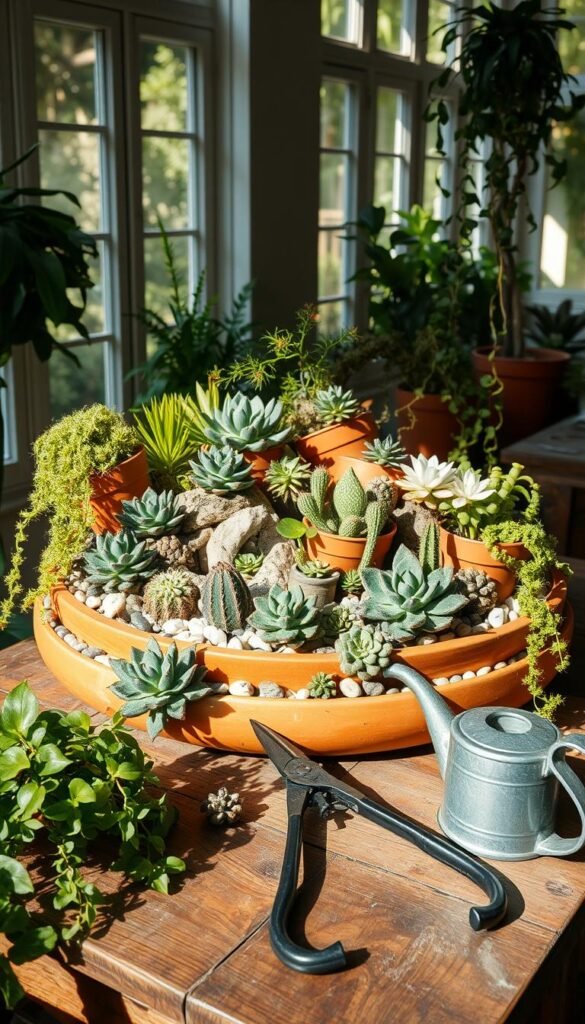
Your living masterpiece thrives with smart care techniques tailored to its desert roots. Unlike traditional houseplants, these arrangements demand specialized attention to water distribution and seasonal adjustments. Master these elements, and your creation becomes a resilient focal point that outlasts cut flowers.
Watering, Light, and Fertilizing Guidelines
Think of hydration as surgical precision. Use a narrow-spout can to deliver water directly to root zones, avoiding moisture on leaves. During active growth in spring and summer, hydrate every 14 days. When winter dormancy hits, stretch intervals to 3-4 weeks.
Bright light fuels desert dwellers, but placement matters. South-facing windows suit cacti, while mixed varieties prefer filtered afternoon rays. Rotate the dish weekly for even exposure – lopsided growth hints at inadequate lighting.
Fertilize like you’re seasoning soup – a light sprinkle in spring only. Dilute liquid kelp to half-strength for gentle nourishment. Overfed plants stretch awkwardly or develop weak stems.
Managing Topdressing and Drainage Enhancements
Decorative stones do more than dazzle. A 1/4″ layer of crushed quartz or lava rock slows evaporation and anchors shallow roots. If soil surfaces develop salt crusts, gently replace the topdressing every 6 months.
Spot drainage issues early. Water pooling under the dish signals blocked holes – unclog with a toothpick. For containers without built-in drainage, add extra perlite to the soil mix. Your plants will reward you with plump, vibrant growth that defies their compact home.
Exploring Creative Design and Styling Options
Unleash your inner artist by blending textures and themes in your living arrangement. Thoughtful combinations turn simple containers into eye-catching displays that reflect your unique taste. Let’s dive into techniques that elevate basic plant groupings into curated art pieces.
Mixing Plant Varieties and Colors
Pair spiky barrel cacti with fuzzy kalanchoe for tactile contrast. Choose specimens in complementary colors – silvery blues against rusty reds create desert vibes. A golden rat tail cactus adds pops of sunshine between green varieties.
Use this quick reference table to match plants by visual impact:
| Design Style | Plant Types | Color Palette |
|---|---|---|
| Desert Minimalist | Agave, Haworthia | Greens + Terracotta |
| Fairy Wonderland | Sedum, Echeveria | Pinks + Purples |
| Modern Geometric | Sansevieria, Gasteria | Monochrome + Metallics |
Incorporating Unique Adornments
Transform your space with miniature fairy garden bridges nestled among pebble paths. Glass chips mimic magical ponds when arranged around a flowering succulent. For desert themes, weathered driftwood adds rugged character without overwhelming plants.
Balance is key. A single crystal cluster draws attention to your star plant. Miniature animal figurines should face inward, creating hidden stories within the design.
Customizing Your Personal Flair
Express your style through material choices. Polished stones suit contemporary spaces, while moss-covered rocks enhance woodland fairy gardens. Try colored sand layers to represent different desert regions.
Rotate seasonal accents – tiny pumpkins for fall, glittery snowflakes in winter. Your living art evolves with your mood, always fresh yet always low-fuss. What story will your dish garden tell today?
Troubleshooting and Ongoing Maintenance Tips
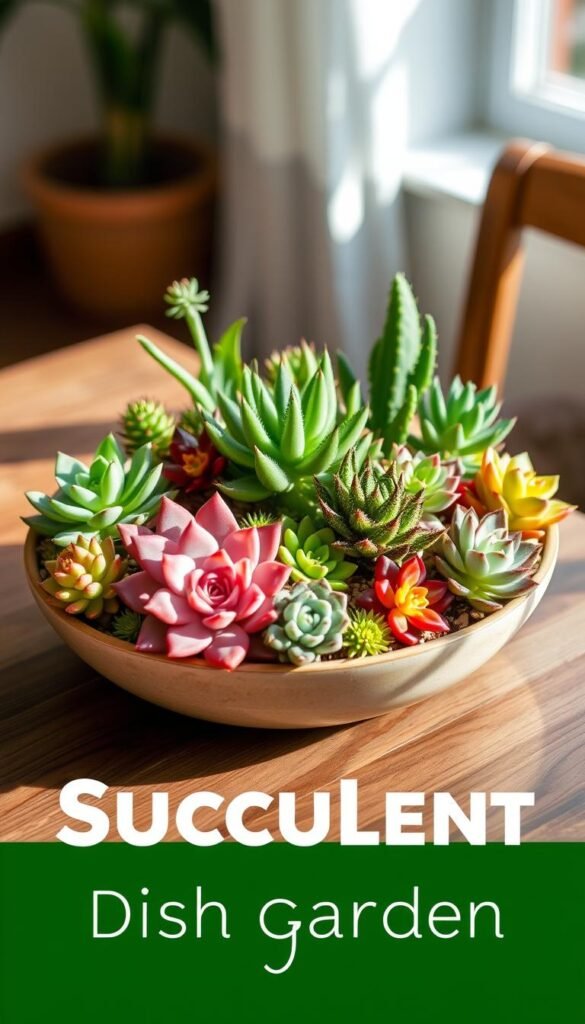
Your living sculpture needs occasional tune-ups to stay vibrant. Like any thriving ecosystem, dish gardens require strategic adjustments as plants mature. Let’s explore solutions for common challenges that keep your arrangement looking fresh.
Smart Space Management
Watch for roots peeking through gravel or leaves pressing against container edges – these signal overcrowding. Make sure to reposition plants every 6 months using chopsticks. Trim overgrown specimens with sterilized scissors:
- Cut at 45° angles above leaf nodes
- Remove yellowing lower leaves first
- Save healthy cuttings for propagation
When plants double in size, divide your garden into smaller clusters. Keep slow-growers like haworthia together, and give fast-spreading sedums their own space.
Defense Against Unwanted Guests
Spider mites hate humidity. Mist plants weekly with diluted neem oil (1 tsp per quart) to deter pests. Make sure new additions quarantine for 10 days before joining your display. Spot these red flags:
- Webbing between spines
- White cotton-like patches
- Sudden leaf drop
Adjust watering frequency when using decorative stones. Topdressings slow evaporation – wait until soil dries completely before rehydrating. Pro tip: Use a moisture meter for precision.
“Preventive care beats crisis management every time. Inspect your garden during weekly rotations – it’s like giving your plants a quick health checkup.”
Final Touches and Enjoying Your Unique Dish Garden
Your living masterpiece deserves a prime spot where it can thrive and inspire. Position it 10 feet from bay windows to soak up gentle sunlight without scorching delicate leaves. Dining room tables and coffee surfaces become instant conversation starters when topped with these earthy arrangements.
Rotate your creation seasonally to maintain balanced growth. Each spring, refresh the soil with a sprinkle of worm compost – nature’s slow-release buffet. This simple ritual fuels vibrant colors and compact growth patterns.
Discover how different spaces elevate your garden’s charm. Sunny kitchen nooks boost aloe vera vitality, while office desks benefit from their air-purifying magic. Pair with compact patio designs for seamless indoor-outdoor style transitions.
Watch your miniature ecosystem evolve over years. Moss may creep between stones, adding whimsical texture. Spiky specimens slowly sculpt themselves into living architecture. Every change tells your plant’s unique story.
Let this project spark new green adventures. As confidence grows, so might your collection – perhaps a succulent dish trio for every room. However you expand, remember: great gardens begin with one bold step.

